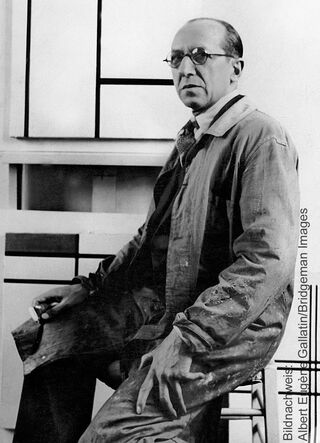Stick umbrella "Composition in Red, Blue and Yellow"
Stick umbrella "Composition in Red, Blue and Yellow"
Quick info
ars mundi Exclusive Edition | automatic | length 86 cm | Ø canopy 100 cm
Detailed description
Stick umbrella "Composition in Red, Blue and Yellow"
Artful automatic umbrella inspired by a motif by Piet Mondrian. With polyester canopy, fibreglass frame, handle and shaft made of black plastic. Length 86 cm. Diameter canopy 100 cm. ars mundi Exclusive Edition.
Customer reviews
Toller Schirm. Schwarze Kleidung, rote Tasche, rote Schuhe und dieser Schirm. Ein echter Hingucker. So macht Regen Spaß !

About Piet Mondrian
1872-1944
It is hard to imagine that Piet Mondrian's strictly geometric compositions had their origins in painterly, filigree landscape studies. At the age of 20, as a student of the Art Academy in Amsterdam, he was drawn to Impressionism. In the neutral Netherlands, he was spared the turmoil of the First World War for a long time and was able to follow his inspiration and theosophical studies. There the first Fauvist and Neo-Impressionist elements appeared in his paintings.
In Paris, which he visited for the first time in 1912, he took part in several "Salons des Indépendants", where he was influenced by the cubism of Georges Braque and Pablo Picasso. Mondrian for example reduced the lines of a tree until the form of the tree is barely discernable and black, orthogonal bars divided the picture surface and becomes secondary to the overall composition of vertical and horizontal lines, he filled the spaces in between with white and primary colours.
Because of his profound knowledge of abstraction, he co-founded the painter, designer and architect group "De Stijl" in 1917 - the Dutch counterpart to the German group "Bauhaus". In his paintings, everything should be in balance, the depth effect should disappear so that "pure reality" remains.
Mondrian's visionary style left clear traces in art, design and architecture, also in New York, where the artist finally emigrated in 1940.
Graphic or sculpture edition that was initiated by ars mundi and is available only at ars mundi or at distribution partners licensed by ars mundi.
Collective term for the painters and sculptors of the 20th century, such as Pablo Picasso, Salvador Dalí, Joan Miró, Marc Chagall and others, whose works are the most recognized in our times.


